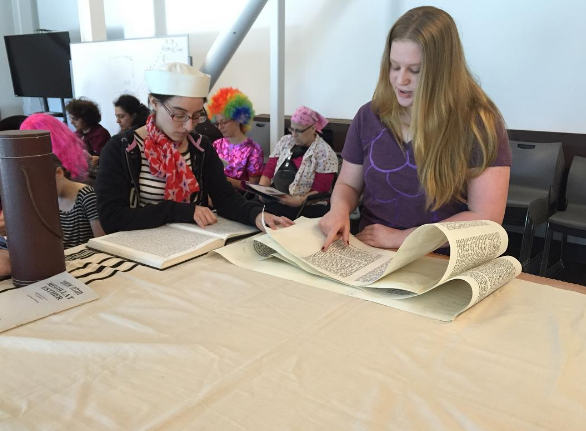Purim marks first women’s Megillah reading at school in six years

HISTORY: From top, freshman Abby Blumofe and alumna Sara Smith ’04 read from Megillat Esther.
May 1, 2016
By Clara Sandler, Staff Writer
Women have been playing an important role in the story of Purim since Vashti and Queen Esther, so it seemed fitting when 45 women gathered to hear an all-female reading of Megillat Esther on Purim morning, March 24, organized by Judaic Studies teacher Mrs. Atara Segal.
Held in the large Beit Midrash on the roof, it was a first for the new building and the first in six years, but not a first for the school. In fact, one of those who read was alumna Sara Smith ’04, who organized Shalhevet’s first women’s megillah reading in 2001.
“It’s important for women and young girls to see that they can also contribute,” said Sara, who is working on a Ph.D. in Jewish History at NYU.
“Being able to lain and pick up a megillah is a really amazing skill. It’s nice to have something and to feel proud because women are so often sitting in shul on the other side of the mechitzah and this is way for us to take ownership.”
Chanting, or laining, Megillat Esther requires memorizing the vowels and the trope, because it must be read from a klaf, or scroll, and a klaf has no vowels or musical symbols. That makes it challenging for girls, who almost never lain during the rest of the year.
Sara said when she started the megillah reading in ninth grade, it was a break-away reading on Purim night from the main school reading, with about 20 people present.
It grew for a few years and then apparently died out. Music teacher Mrs. Joelle Keene remembers trying to keep it going and finding not enough girls who were interested.
“I remember being able to get a few girls but not enough to cover all 10 perakim,” or chapters, Mrs. Keene said.
After that, it was hard to restart. Ms. Segal said lack of planning was at fault in more recent years. But this year was different.
“I thought about it early enough to recruit people to do it,” Ms. Segal said. “It’s not a policy thing, it’s just a practical thing about getting it together.”
This year, freshman Abby Blumofe opened up the reading by saying the blessings, and readings chapters one and five.
History teacher Mrs. Tove Sunshine read chapter two, and Ms, Segal read chapters three and seven.
Mrs. Keene read chapter four, and freshman Jamie Berman, who learned how to lain from her Bat Mitzvah tutor, read chapter six.
Alumna Sara Smith read chapters 8 and 9, and sophomore Noa Segal read chapter 10.
There were about 15 students in attendance, many of whom brought their mothers and sisters to the event. Haman-booing was tame and polite.
Some came in costume, others in regular clothing and a funny hat or just regular clothing.
Abby enjoyed reading the Megillah because it reminded her of her bat mitzvah, which was on Purim three years ago.
“It’s not every day that women get to lain, and this was truly an amazing experience,” said Abby.
According to Rabbi Yehuda Henkin of Nishmat in Israel, where Ms. Segal will be living next year studying to be a studying to be a yoetzet halacha (see related story, this page), there are three opinions about women reading megillah.
One states that men and women are equally obligated in the mitzvah of kriat hamegillah (reading the text) and therefore either gender can read for the other.
Another holds that women are only obligated to hear the reading, and a third opinion posits that although men and women have the same level of obligation, women still cannot read.
Rabbi Henkin concludes by saying that women are able to read megillah.
“There has emerged a widespread practice to have a second megillah reading for women, and in such circumstances it is entirely proper for a woman or women to read the megillah,” Rabbi Henkin writes in his book Equality Lost: Essays in Torah Commentary, Halacha and Jewish Thought.
Shalhevet Principal Reb Noam Weissman was happy that this gives women a voice.
“The reason we allow it is because it is totally mutar, (permitted), and if it is totally mutar, we deeply believe our young women should be owners of their Jewish experience and participate in their Jewish life like this,” Reb Noam said.
Mrs. Segal said that it was pretty easy to find lainers this year after publicizing it on Schoology.
Sara Smith lained the entire Megillah twice this year, and also participated in two different women’s readings as well. She said it was special to return to Shalhevet for one of them.
“The Shalhevet one was special for me because there was student participation and faculty participation,” Sara said. “It really felt like a group effort, and it was nice to see everyone sharing the responsibility of the mitzvah of mikra megillah.”












